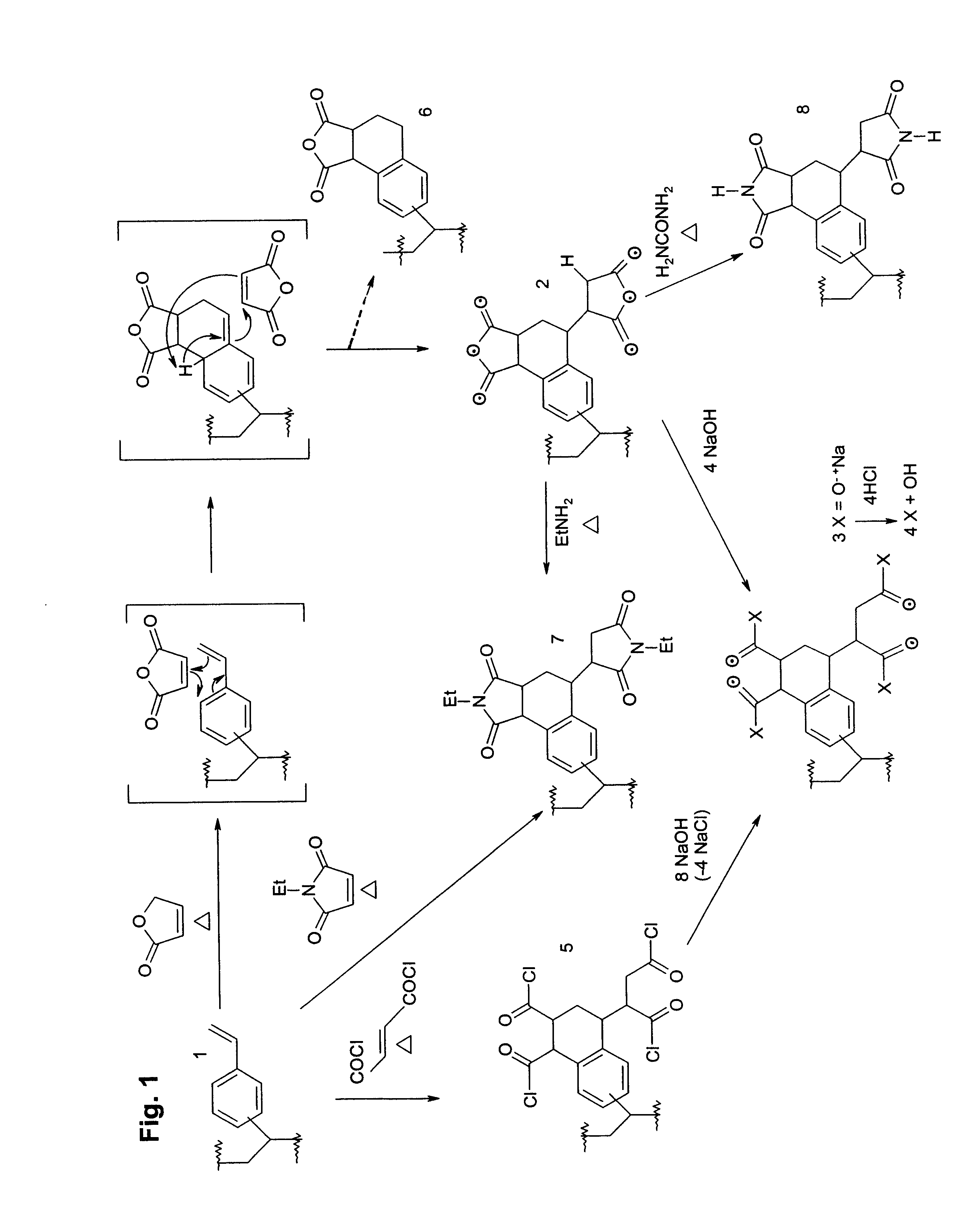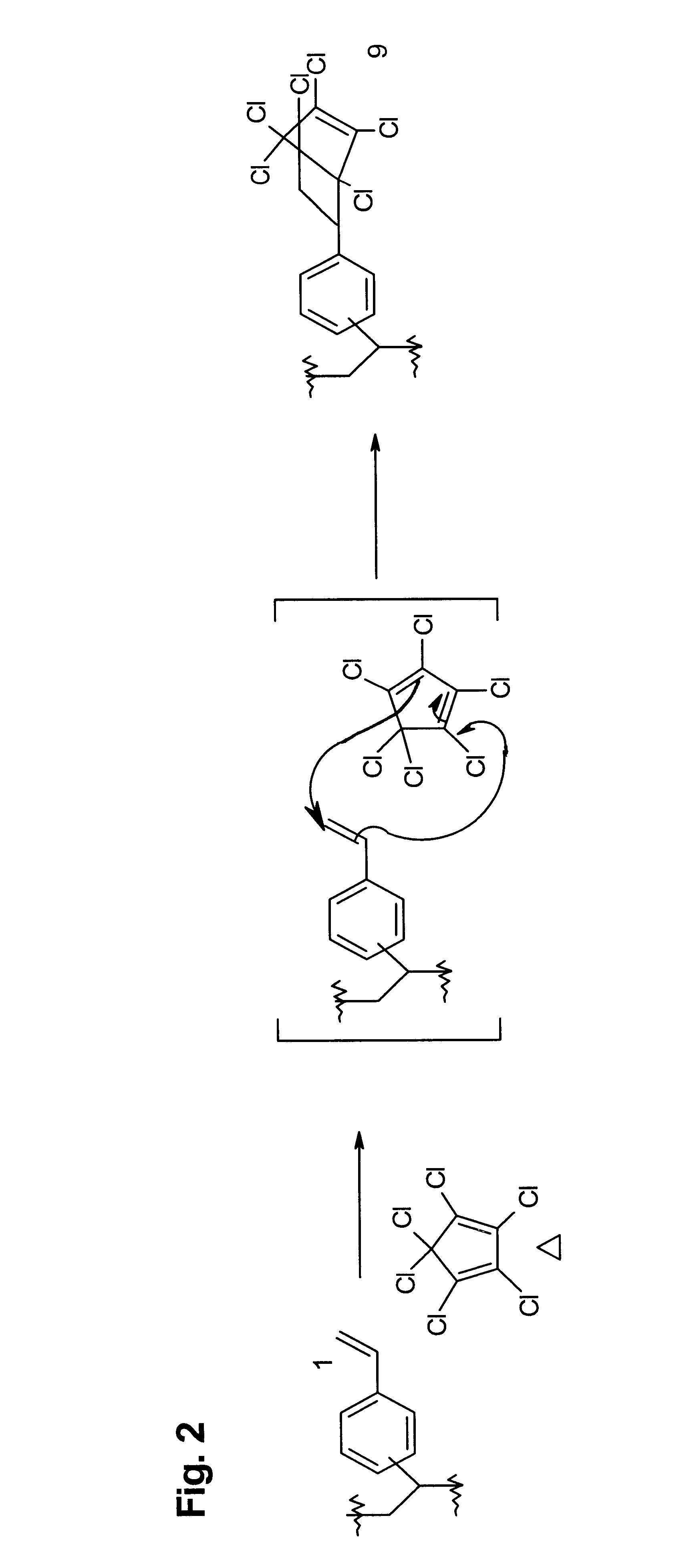Cycloaddition functional polymers from (vinyl) polystyrene
a functional polymer and cycloaddition technology, applied in the field of cycloaddition functional polymers from (vinyl) polystyrene, can solve the problems of aryl-heteroatom functional groups that may be unstable in acidic conditions, intrinsically deficient products in activity or stability, and unstable benzyl-heteroatom bonds, etc., to achieve simple conditions and apparatus
- Summary
- Abstract
- Description
- Claims
- Application Information
AI Technical Summary
Benefits of technology
Problems solved by technology
Method used
Image
Examples
example 1
Functional polymer that comprises repeat units having structures corresponding to end products of cycloaddition of polymeric 1-(vinylphenyl)ethylene repeat units with maleic anhyndee electron-poor alkene (2). To 0.34 X.sub.f poly(divinylbenzene) beads prepared with toluene as porogen 1a (11.46 g, 32.66 mmol) was added a solution of maleic anhydride (3.50 g, 35 mmol) in 50 mL toluene (bp 111.degree. C.). The mixture was refluxed 12 h and the beads filtered while hot. The beads were then washed with 30 mL hot toluene 9X, 30 mL acetone 7X, then ether, and dried in a vacuum oven 48 h at 60.degree. C., yielding 14.88 g 2a as light beige beads: IR (Si wafer) 1868 (w), 1789 (s), 1728 (w), 1630 (w, weaker than 1a), 1217, 990 (w, weaker than 1a), 890-910 (br) cm.sup.-1 ; .sup.13 C CP-MAS NMR .delta. 171 (DD, COOCO), 145 (DD, disubstituted aryl C-R), 135 (DD, trisubstituted aryl C-R) and 127 (aryl C-H) ppm, 40, 30 and 22 ppm (alkyl CH and CH.sub.2), and 15 ppm (DD, CH.sub.3). Anal. Calcd for ...
example 2
Functional polymer that comprises repeat units having structures corresponding to end products of cycloaddition of polymeric 1-(vinylphenyl)ethylene repeat units with maleic anhydride electron-poor alkene (2)--magnetite-impregnated. Amberlite.RTM. XAD-16 beads of 0.35 X.sub.f polymeric 1-(vinylphenyl)ethylene-containing polymer 1c (9.00 g, 26.1 mmol) were soaked in a 100 mL methanol solution containing FeCl.sub.2 (5.00 g, 40.0 mmol) and FeCl.sub.3 (5.00 g, 31.0 mmol) for 12 h at room temperature in air, then filtered. The moist beads were then transferred to an Erlenmeyer flask containing 250 mL of 1 M NH.sub.3(aq) and boiled gently in air for 30 min. The resulting dark brown beads were then filtered over 425 mm wire mesh and washed with boiling water several times until filtrate was clear and colourless. The beads were then dried in vacuo 3 days at 75.degree. C. until constant weight, giving 10.11 g of dark brown beads, 1d. To 4.00 g of these was added a solution of maleic anhydrid...
example 3
Functional polymer that comprises repeat units having structures corresponding to end products of cycloaddition of polymeric 1-(vinylphenyl)ethylene repeat units with disodium maleate (3) or maleic acid (4) electron-poor alkenes. A sample of 2a was treated with aqueous base as for the pH back titration procedure, and the resulting 3a examined spectroscopically: FT-IR (KBr) 3600-100, 1572, 1406, 1217 cm.sup.-1 ; .sup.13 C CP-MAS NMR .delta. 184 (DD), 145 (DD), 138 (DD), 127, 40, 30, 32, 15 (DD). Back titration protonated this to 4a.
PUM
| Property | Measurement | Unit |
|---|---|---|
| temperature | aaaaa | aaaaa |
| weight | aaaaa | aaaaa |
| density | aaaaa | aaaaa |
Abstract
Description
Claims
Application Information
 Login to View More
Login to View More - R&D
- Intellectual Property
- Life Sciences
- Materials
- Tech Scout
- Unparalleled Data Quality
- Higher Quality Content
- 60% Fewer Hallucinations
Browse by: Latest US Patents, China's latest patents, Technical Efficacy Thesaurus, Application Domain, Technology Topic, Popular Technical Reports.
© 2025 PatSnap. All rights reserved.Legal|Privacy policy|Modern Slavery Act Transparency Statement|Sitemap|About US| Contact US: help@patsnap.com



